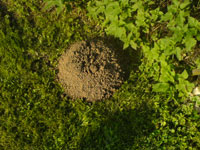Damage Identification
 A mole's fur is soft and brownish to grayish with silver highlights. When brushed, the fur offers no resistance in either direction; this enables the mole to travel either backward or forward within burrows.
A mole's fur is soft and brownish to grayish with silver highlights. When brushed, the fur offers no resistance in either direction; this enables the mole to travel either backward or forward within burrows.
mole hillMoles may be found in woodlands, grasslands, and lawns. They construct extensive underground passageways—shallow surface tunnels for spring, summer and fall, and deep, permanent tunnels for winter use. Nest cavities are located underground, connecting with the deep tunnels.
Moles have high energy requirements. They actively feed day and night at all times of the year. They feed on mature insects and snail larvae, spiders, small vertebrates, earthworms, and occasionally take small amounts of vegetation. Earthworms and white grubs are favorite foods.
Moles prefer loose, sandy loam soils and avoid heavy, dry clay soils. Mole activity in lawns or fields usually shows up as ridges of upheaved soil created where the runways were constructed as the animals moved about foraging for food. Some of these tunnels are used as travel lanes and may be abandoned immediately after being dug. Mounds of soil called molehills may be brought to the surface of the ground as moles dig deep, permanent tunnels and nest cavities.